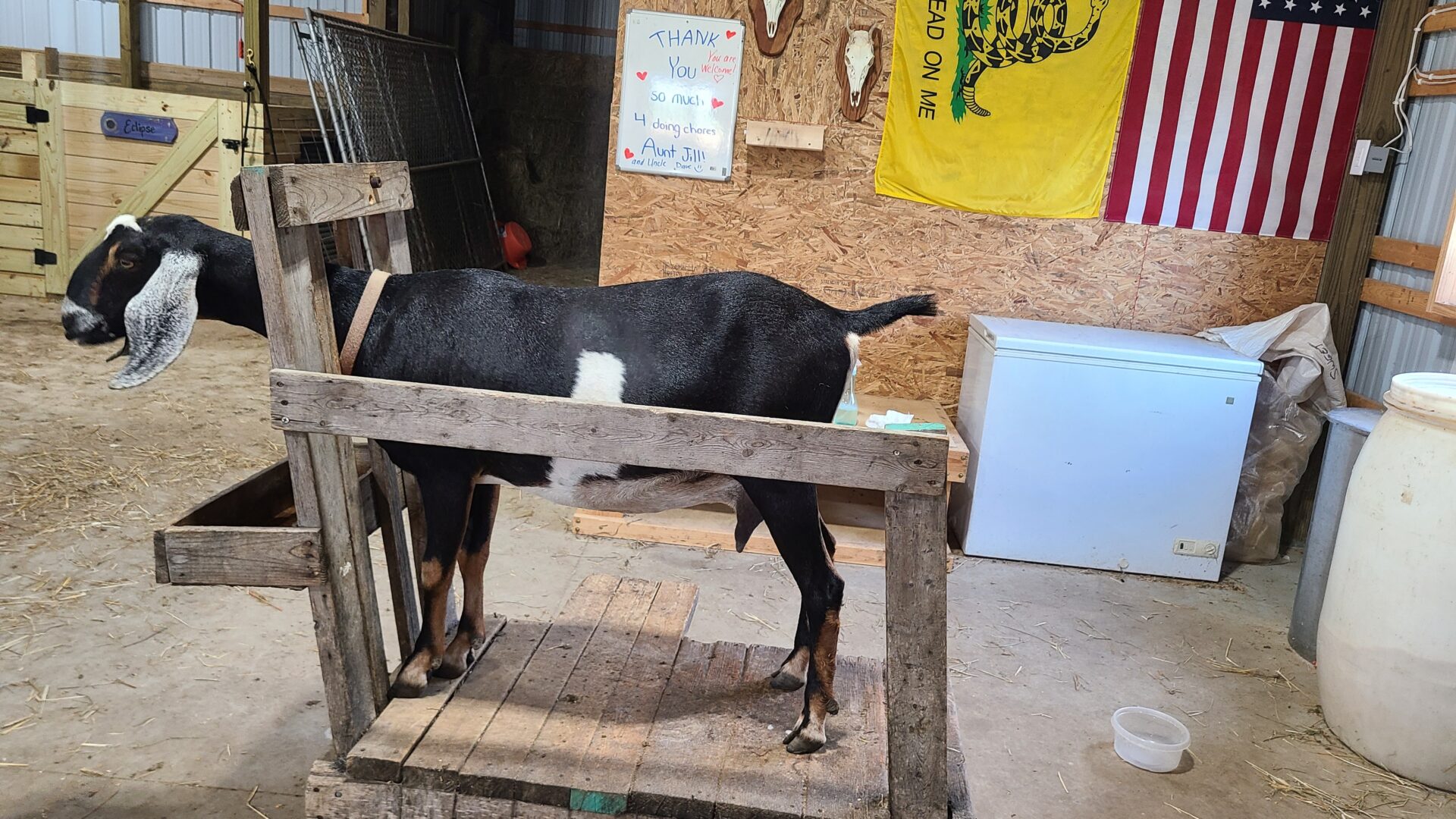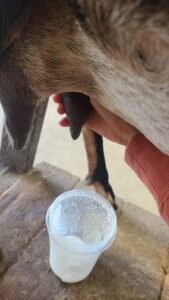There are several approaches that you can take to help dry-off a dairy animal. This is the evidence-based process we use with our dairy goats, with much success. A timeline for gradual reduction is provided which makes the animal’s comfort and health a top priority.

This post contains affiliate links. As an Amazon Associate, I earn from qualifying purchases.
For me, breeding season is just around the corner. The smell of rutting bucks is in the air and I know that it means soon I will be taking a break from milking so that my does can give all of their energy to growing strong, healthy babies.
I am not one to just stop milking cold-turkey. I gradually reduce the amount of milk that I collect so that my does’ bodies can adjust their supply. This helps to avoid engorgement of the teats/ udder and the discomfort that comes with it.
There are many different opinions on and methods for drying-off dairy animals. While some farmers use antibiotics and teat sealants, I prefer not to administer any medication and instead use gradual reduction of milk collection, while simultaneously cutting back grain rations. This has worked well for me over the years, even with my highest producing Nubian does.
Research on Drying-Off Methods
My choice to dry-off dairy goats through gradual reduction is supported by research on dairy cattle. Unfortunately, very few studies have been published on small ruminants (like goats), but the data from large ruminants (like cattle) is still useful. Biologically, cattle and goats are very similar and results from studies involving cattle can be assumed under similar circumstances involving other ruminant species.
Vilar and Rajala-Schultz (2020) found that gradually stopping milking over a period of several days reduced final milk output, sped up the shrinkage of mammary tissues, and increased cow comfort and welfare. They recommend a reduction from twice daily milking to a 5-7 day period of milking once daily before stopping milking altogether. They also recommend reducing feed intake over this same period of time.
Results from another study found that in high-producing dairy cattle, abrupt cessation in milking (not reducing gradually) was accompanied by signs of distress in cows and measurable increases in inflammatory cells (Silanikove, Merin, Shapiro, and Leitner, 2013).
Similarly, Natzke, Everett, and Bray (1975) reported that drying-off through intermittent milking was correlated with fewer mastitis infections at subsequent calving than stopping milking abruptly in dairy cattle. Although this study is outdated, the results are compelling because it was well designed and had a large sample size.

Drying-Off Through Gradual Reduction
When planning to dry-off a milking doe, first I choose the day I want to be completely done milking (it needs to be at least 2 weeks in the future). Then, I implement the gradual reduction protocol outlined below.
My gradual reduction protocol is essentially milking less and feeding less grain over the span of two weeks. In my experience, this results in a gentle transition to the goat’s dry period.
I milk my goats twice daily, morning and evening, so for the first 3 days of the 2-week dry-off protocol I still milk twice daily, but reduce the amount I collect at one milking by 50% and give the doe half of the usual amount of grain. For example, if she usually produces 2 quarts per milking session, I stop milking when I get 1 quart in the evening.
For days 4-6, I reduce the morning milk collection by 50% as well. At this time, I will still be milking twice daily, but only collecting one half of the total volume that I had collected before starting the gradual reduction protocol. I also give half of the grain that the doe initially was consuming (I do not restrict hay or forage, only grain intake).
At day 7, I transition to once daily milking. For me, it is the evening milking that I eliminate first, but you can do what works best for your schedule.
Starting at day 10, I go to milking once every other day. Depending on your doe’s body condition, you may want to feed limited amounts of grain on the off/non-milking day.
By day 14, your doe should be producing very little milk. At this point, she can be considered dry and the remaining milk in her udder will slowly resorb and the mammary tissues will shrink up.
Calendar for Drying-Off Through Gradual Reduction
Here is a visual representation showing the dry-off protocol I use, explained above. The calendar shows what should be taking place over the 2-week span of gradual reduction.
| Day 1 | Day 2 | Day 3 | Day 4 | Day 5 | Day 6 | Day 7 |
| Morning milking: Normal Evening milking: Reduce feed and milk collection by 50% | Morning milking: Normal Evening milking: Reduce feed and milk collection by 50% | Morning milking: Normal Evening milking: Reduce feed and milk collection by 50% | Morning milking: Reduce feed and milk collection by 50% Evening milking: Reduce feed and milk collection by 50% | Morning milking: Reduce feed and milk collection by 50% Evening milking: Reduce feed and milk collection by 50% | Morning milking: Reduce feed and milk collection by 50% Evening milking: Reduce feed and milk collection by 50% | Morning milking: Reduce feed and milk collection by 50% No evening milking or grain |
| Day 8 | Day 9 | Day 10 | Day 11 | Day 12 | Day 13 | Day 14 |
| Morning milking: Reduce feed and milk collection by 50% No evening milking or grain | Morning milking: Reduce feed and milk collection by 50% No evening milking or grain | No morning milking, give limited grain No evening milking or grain | Morning milking: Reduce feed and milk collection by 50% No evening milking or grain | No morning milking, give limited grain No evening milking or grain | Morning milking: Reduce feed and milk collection by 50% No evening milking or grain | No morning milking, give limited grain No evening milking or grain |
Additional Notes on Drying-off
As you milk less, tightness in the udder is normal and can be expected between sessions. Watch for signs of mastitis and use a mastitis test if necessary. Before milking, be sure to use an appropriate teat and udder cleaning solution. I make my own teat and udder spray with essential oils, click here for the recipe.
While their requirements are not as high as when lactating, it is important that dry does receive adequate nutrition. I give my dry does limited amounts of grain once daily, and 24-hour access to hay or forage, as well as loose minerals. For ideas on how to supply minerals to goats or information on making PVC mineral feeders for goats, click the links to read these related articles.
References
Natzke RP, Everett RW, Bray DR. Effect of drying off practices on mastitis infection. J Dairy Sci. 1975 Dec;58(12):1828-35. doi: 10.3168/jds.S0022-0302(75)84794-1. PMID: 1206136.
Silanikove N, Merin U, Shapiro F, Leitner G. Early mammary gland metabolic and immune responses during natural-like and forceful drying-off in high-yielding dairy cows. J Dairy Sci. 2013 Oct;96(10):6400-11. doi: 10.3168/jds.2013-6740. Epub 2013 Aug 9. PMID: 23932133.
Vilar MJ, Rajala-Schultz PJ. Dry-off and dairy cow udder health and welfare: Effects of different milk cessation methods. Vet J. 2020 Aug;262:105503. doi: 10.1016/j.tvjl.2020.105503. Epub 2020 Jul 5. PMID: 32792097.

Mother, farmer, author, and teacher by trade… She loves tending to things and watching them grow!
